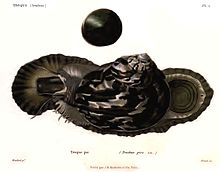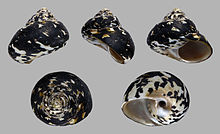| Cittarium pica Temporal range:
| |
|---|---|

| |
| A colored illustration of a live Cittarium pica, showing the inner surface of the operculum at the top | |

| |
| Five views of a shell of Cittarium pica | |
| Scientific classification | |
| Domain: | Eukaryota |
| Kingdom: | Animalia |
| Phylum: | Mollusca |
| Class: | Gastropoda |
| Subclass: | Vetigastropoda |
| Order: | Trochida |
| Superfamily: | Trochoidea |
| Family: | Tegulidae |
| Genus: | Cittarium |
| Species: | C. pica
|
| Binomial name | |
| Cittarium pica | |
| Synonyms[1][2] | |
Cittarium pica, common name the West Indian top shell or magpie shell, is a species of large edible sea snail, a marine gastropod mollusk in the family Tegulidae. This species has a large black and white shell.
This snail is known as "wilk" or "wilks" (or sometimes as "whelks") in the English-speaking Caribbean islands of the West Indies, where this is a popular food item. The word "will" or "wilks" can be used both as a singular form and a plural. This species is however not at all closely related to the species that are known as whelks in the U.S. and in Europe. In some Spanish-speaking parts of the Caribbean, when used as a food source Cittarium pica is known as bulgao, or simply as caracoles (snails, in Spanish). In Venezuela it is called quigua;[3] in Cuba it is called cigua.
Cittarium pica is considered the third most economically important invertebrate species in the Caribbean, after the spiny lobster (Panulirus argus) and the queen conch (Eustrombus gigas). It has gone locally extinct in some habitats due to overfishing and overexploitation.[4][5][6]
- ^ "The Paleobiology Database". Cittarium pica Linnaeus, 1758 (Top Snail). Retrieved 14 April 2010.
- ^ Cite error: The named reference
Malacologwas invoked but never defined (see the help page). - ^ Toller, W. (2003). "U.S.V.I. Animal Fact Sheet #15 Whelk" (PDF). Department of Planning and Natural Resources Division of Fish and Wildlife. Archived from the original (PDF) on 16 August 2011. Retrieved 13 October 2009.
- ^ Cervigón, F. (1993). "Gastropods". In Carpenter, K.E. (ed.). Field guide to the commercial marine and brackish-water resources of the northern coast of South America. FAO species identification sheets for fishery purposes. Rome: FAO. p. 513. ISBN 92-5-103129-0.
- ^ Leal, J.H. (2002). Gastropods. p. 99-147. In: Carpenter, K.E. (ed.).The living marine resources of the Western Central Atlantic. Volume 1: Introduction, molluscs, crustaceans, hagfishes, sharks, batoid fishes, and chimaeras. FAO Species Identification Guide for Fishery Purposes and American Society of Ichthyologists and Herpetologists Special Publication No. 5. 1600p.
- ^ Sartwell, T. Wood, J. B.; Valdivia, A. (eds.). "Marine Invertebrates of Bermuda". West Indian Top Shell (Cittarium pica). BBSR. Retrieved 19 April 2010.